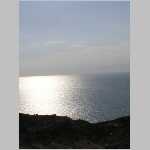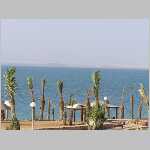|
The
Dead Sea (Totes
Meer in German) is a saltwater lake located at the border
between Israel and
Jordan, and its
surroundings, particularly the
Jordan Valley, are of great historical, geographical, and
environmental significance.
Dead Sea (Totes Meer) and the
Jordan Valley:
-
Geography and Location:
-
The
Dead Sea lies
in the Jordan Rift
Valley, part of the larger
Great Rift Valley,
which stretches from
Syria down to
Mozambique in southeastern Africa.
-
The
Jordan River
flows into the Dead Sea, from the north, and is one of the
primary contributors to its water. The Dead Sea is situated at
the lowest point
on Earth’s surface, about
430 meters (1,411 feet)
below sea level.
-
The Dead Sea is
bordered by Israel
and the West Bank
on the western side, and
Jordan on the eastern side. It is approximately
50 kilometers (31 miles)
long and 15 kilometers
(9 miles) wide at its widest point.
-
The Jordan Valley:
-
The
Jordan Valley
is the fertile area that stretches along the
Jordan River.
It is significant both
geographically and
historically,
playing a central role in the development of ancient
civilizations.
-
The valley is
bordered by the
mountainous regions of Israel to the west and
Jordan to the
east. It also serves as a critical environmental and
agricultural area for both countries.
-
The
Jordan Valley
is home to some of the most important
archaeological
and biblical sites,
such as Bethany Beyond
the Jordan, which is believed to be the site of
Jesus' baptism.
-
Water Sources and Issues:
-
The
Jordan River
feeds the Dead Sea, but water diversion for agricultural use,
and the construction of dams along the Jordan River, have
dramatically reduced the amount of water flowing into the Dead
Sea.
-
As a result, the
water level of the
Dead Sea has been declining rapidly, leading to
environmental issues like the formation of
sinkholes
around its shores.
-
Both
Israel and
Jordan have
been involved in regional discussions to address these
environmental challenges, including proposals like the
Red Sea-Dead Sea
Project, which aims to divert water from the Red Sea to
replenish the Dead Sea.
-
Environmental and
Ecological Importance:
-
The
Dead Sea is a
highly saline lake,
which has created unique conditions for the ecosystem. Because
of its extreme salinity, very few organisms can survive in the
water, hence the name "Dead Sea." However, the surrounding areas
are home to a variety of
desert flora and fauna,
especially around the
Ein Gedi Nature Reserve.
-
Ein Gedi, on
the western shore of the Dead Sea, is a lush oasis with hot
springs and a rich diversity of wildlife, contrasting with the
otherwise harsh desert landscape of the area.
-
Tourism and Health
Benefits:
-
The
Dead Sea has
been a popular tourist destination for centuries, offering
therapeutic
benefits due to its
high mineral content in the water and mud. The minerals
in the Dead Sea, such as
magnesium,
calcium,
potassium,
and bromine,
are believed to be beneficial for
skin conditions
and rheumatic diseases.
-
Tourists flock to
the area to float in the highly saline water, as its density
makes it impossible to sink, offering a unique and memorable
experience.
-
Both
Israel and
Jordan have
developed luxury resorts and spas along the shores of the Dead
Sea, where visitors can enjoy mud baths, massages, and
treatments that make use of the region’s mineral-rich mud and
water.
-
Historical Significance:
-
The
Jordan Valley
is also historically
significant, particularly in the context of the
biblical and
ancient civilizations.
It is believed to be the setting for many events in the
Old Testament,
including the story of the
Israelites' exodus
from Egypt and the
baptism of Jesus
Christ.
-
The Dead Sea
Scrolls, a collection of
ancient manuscripts,
were discovered in
Qumran, near the
northern shore
of the Dead Sea, and these scrolls have greatly enhanced our
understanding of ancient Jewish history and religious texts.
-
Cultural and Spiritual
Importance:
-
Both the
Dead Sea and
the Jordan River
have significant
spiritual and
religious meanings for
Jews,
Christians,
and Muslims.
The Jordan River
is associated with
baptism, and the
Dead Sea is
considered sacred by many cultures.
-
Pilgrims from
around the world come to the region to visit sites such as
Bethany Beyond the
Jordan in Jordan, which is traditionally regarded as
the location where
Jesus was baptized by
John the Baptist.
Challenges and Future of the
Dead Sea:
-
The
decline in water levels
and the environmental degradation of the Dead Sea due to human
activity, such as water diversion and industrial use, remain
significant concerns for both
Israel and
Jordan.
-
Collaboration
between the two countries to manage water resources and address the
challenges facing the Dead Sea is essential for the preservation of
this unique ecosystem.
Conclusion:
The
Dead Sea and the
Jordan Valley are
rich in natural,
historical, and
cultural significance.
From the therapeutic benefits of the mineral-rich water and mud, to its
crucial role in religious history, the Dead Sea remains one of the most
unique natural wonders in the world. Despite the challenges facing its
future, the region continues to be a key destination for travelers,
historians, and pilgrims alike.
|
It looks like you're combining two different terms—"Totes Meer" (German
for "Dead Sea") and "Jordantal" (likely
referring to the Jordan Valley, where the
Dead Sea is located). Let me clarify both concepts and their connection:
1. Totes Meer = Dead Sea (German)
-
Location: Between Jordan
(east) and Israel/Palestine
(west).
-
Key Features:
-
Lowest point on Earth (~430m below sea level).
-
One of the saltiest bodies of water (34% salinity).
-
Famous for floating, therapeutic mud, and
mineral-rich waters.
-
Environmental Crisis: The sea is shrinking
rapidly due to water diversion from the Jordan
River, creating dangerous sinkholes.
2. Jordantal = Jordan Valley (German)
Connection Between the Two
-
The Jordan Valley’s water management directly
impacts the Dead Sea’s survival.
-
Proposed solutions (like the Red Sea-Dead Sea
Canal) aim to refill the Dead Sea using water from the Red
Sea via the Jordan Valley.
Did you mean something specific?
-
Travel tips for the Dead Sea
(Jordan/Israel side)?
-
Environmental issues in the Jordan
Valley affecting the Dead Sea?
-
The German terminology itself?
|
|
 Safaris
Bergsteigen
Wandern
Inselwandern Weltweit
Safaris
Bergsteigen
Wandern
Inselwandern Weltweit
 Europa
Inselwandern
Europa
Inselwandern
 Städtewandern
Städtewandern
 Paintings
Paintings Dirk Rauschenbach
Dirk Rauschenbach
 Safaris
Bergsteigen
Wandern
Inselwandern Weltweit
Safaris
Bergsteigen
Wandern
Inselwandern Weltweit
 Europa
Inselwandern
Europa
Inselwandern
 Städtewandern
Städtewandern
 Paintings
Paintings Dirk Rauschenbach
Dirk Rauschenbach




![]() 26.07.25 Copyright Dirk
Rauschenbach Koelnerstrasse 293 51702 Bergneustadt
Datenschutzerklaerung 02261 9788972 Mail ccooly(
at) web.de
26.07.25 Copyright Dirk
Rauschenbach Koelnerstrasse 293 51702 Bergneustadt
Datenschutzerklaerung 02261 9788972 Mail ccooly(
at) web.de